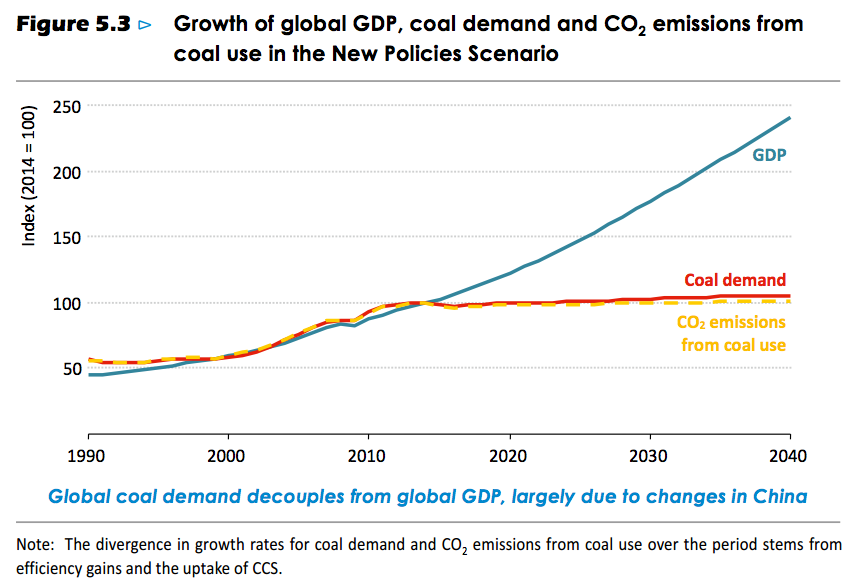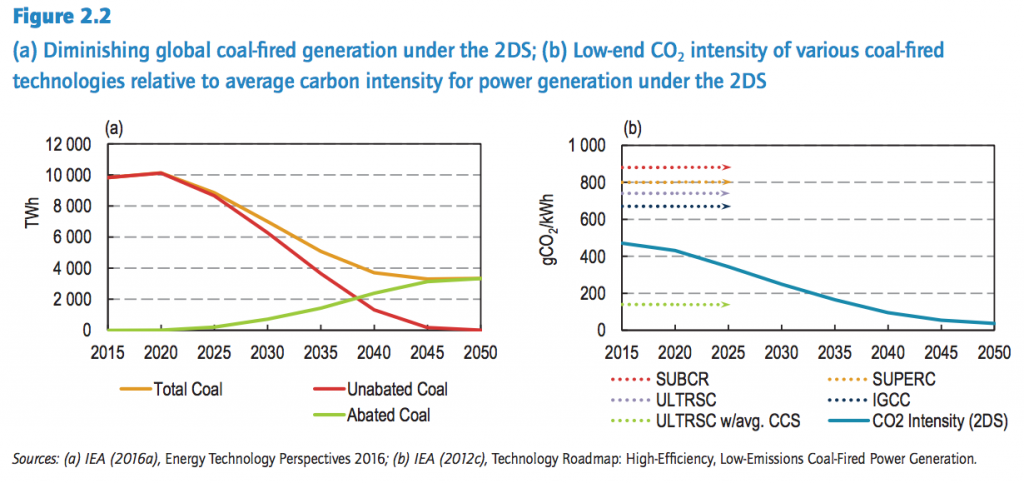
Analysis: IEA cuts coal growth outlook in half as China peaks
Simon Evans
11.16.16The International Energy Agency (IEA) has dramatically scaled back its outlook for coal demand growth over the next 25 years, Carbon Brief analysis shows.
The 2016 World Energy Outlook sees global coal demand rise by 214 million tonnes of oil equivalent (Mtoe) by 2040, less than half the 485Mtoe increase it expected last year. The IEA is also now persuaded that Chinese coal demand peaked in 2013.
Nonetheless, its central outlook sees coal use in 2040 being more than twice as high as needed for a 2C path. This coal disparity is the largest obstacle to meeting global climate goals, the report shows. Carbon Brief looks at what the World Energy Outlook means for coal and the climate.
Coal challenge
Coal is the world’s dirtiest fossil fuel. It was responsible for 46% of global energy-related CO2 emissions in 2014, the IEA says, despite meeting only 29% of demand for energy. As such, efforts to avoid dangerous climate change rely disproportionately on cutting emissions from coal.
The chart below illustrates this point. Current policies and pledges are expected to increase demand for energy across the board, including from coal, oil and gas. To shift to the IEA’s 2C path, coal use in 2040 must fall by 2,000Mtoe, to half of current demand.
Growth in energy demand to 2040, by fuel, under different IEA scenarios in millions of tonnes of oil equivalent (Mtoe). The difference between a 2C path (450 Scenario) and current policies and pledges (New Policies Scenario) is most significant for coal. Source: World Energy Outlook 2016. Chart by Carbon Brief using Highcharts.In this context, the shift in the IEA outlook for coal is a positive sign for global climate efforts. The 2016 World Energy Outlook says coal demand will increase by 214Mtoe by 2040, whereas in 2015 it had expected an increase of 485Mtoe.
“After the rapid expansion of recent years, [coal] growth essentially grinds to a halt,” the IEA says. It now thinks demand will grow by 0.2% per year on average, half the rate expected last year and one quarter of the rate expected in 2012. (It’s worth adding that the IEA still forecasts growing coal demand, despite a record fall in global coal use last year.)

Growth of global GDP, coal demand and CO2 emissions from coal in the IEA’s central New Policies Scenario. The chart shows growth indexed to the levels in 2014. Source: World Energy Outlook 2016.
China peak
The outlook for coal is less rosy because the IEA is now persuaded that Chinese coal demand peaked in 2013. Last year it said that only a “dramatic slowdown” in GDP growth or an “unprecedented pace” of economic restructuring could trigger sustained coal reductions in China.
As a result, last year the IEA didn’t expect Chinese coal demand to peak until around 2030. Now, it sees demand falling 15% by 2040. Last year, it expected a 26% increase in the amount of power China gets from coal by 2040. Now it sees growth of just 4%.
Another way to look at this is that the IEA has cut its forecast for China’s coal-fired power output in 2040 by 907 terawatt hours (TWh), from 5,231TWh to 4,324TWh. This is equivalent to the total annual electricity demand of the UK (338TWh) and France (569TWh) combined.
Chinese coal demand could fall even faster than the IEA expects, given the waning impact of recent fiscal stimulus and reforms that will force grid operations to purchase minimum supplies from renewable sources that were previously curtailed.
The IEA expects China to continue building new coal plants, even though they will run less than 50% of the time. Its outlook has load factors falling to 43% in 2040.
The IEA notes: “China is set to surpass its energy and emissions targets”. Indeed, in the weeks before the IEA published its report, China laid out new targets for the power sector, including an overall cap on coal-fired power capacity and more ambitious targets for low-carbon supplies.
Tim Gould, head the WEO energy supply division, told a launch event in London:
“Coal had a very good first decade of the 2000s, but that boom is over. China led the charge. Chinese demand, in our view, has peaked and falls 15% by 2040…That is offset to a degree by what we see in India and southeast Asia.”
The report says:
“Lower income economies, notably India and countries in Southeast Asia, need to mobilise multiple sources of energy to meet fast growth in consumption; as such they cannot afford, for the moment, to neglect a low cost source of energy [coal] even as they pursue others in parallel.”
Paris compatible
The IEA’s lower outlook for global coal demand is a positive sign for climate efforts. However, the trajectory implied by current policies and pledges remains well short of what would be needed to avoid 2C of warming, as the chart at the top shows.
Fatih Birol, IEA executive director told a launch event in London: “The Paris pledges alone, even fully implemented, will not bring us to the 2C trajectory…let alone below that.”
Indeed, to avoid warming of more than 2C, every coal plant in the world will have to close by around 2050, unless it is fitted with carbon capture and storage (CCS), according to a second IEA report published this month (see chart, below left).
This second IEA report echoes Climate Analytics findings, which conclude that unabated coal must be phased out by 2050 for the Paris goals to be met.
The need to phase out unabated coal applies to plants in India, China and southeast Asia as much as it does to those in Poland, the US or Germany, though the timelines vary.
Though CCS will offer some coal plants a lifeline, this year’s scenarios have “considerably less” reliance on the technology, the IEA says, “given the slow pace at which CCS projects are being demonstrated and tested”.

Left: Coal-fired power generation in the IEA’s 2C scenario. Abated coal uses CCS technology. Right: Average power sector CO2 emissions per kWh in the 2C scenario compared to the emissions from different coal plants. SUBCR is the least efficient subcritical coal. SUPERC is supercritical and ULTRSC is ultra-supercritical. IGCC is integrated combined cycle coal. Source: IEA Energy, Climate Change and Environment: 2016 Insights.
Even if the most efficient ultra-supercritical coal plants are fitted with CCS, they still emit around 150 grammes of CO2 per kilowatt hour (kWh) of electricity generated. This compares to a target range of around 80gCO2/kWh in 2040 in the IEA’s 2C scenario (see chart, above right).
Consequently, coal plants, whether fitted with CCS or not, have little role in IEA scenarios that attempt to meet the upper end of the Paris Agreement ambition. For a 1.5C limit, the IEA says:
“Coal use in power generation would drop dramatically, as its combustion, even with CCS, would entail residual emissions that would be increasingly challenging to compensate elsewhere.”
This is the first time that the IEA has drawn up Paris-compatible scenarios aligned to its warming limits of “well below 2C” and 1.5C. Dr Kamel Ben Naceur, director of the IEA’s sustainable energy policy and technology directorate, tells Carbon Brief that these scenarios will be developed further over the coming year.
The IEA’s “well-below 2C” scenario is based on a 66% probability of avoiding 2C, he explains. This implies a carbon budget that is some 20% smaller than in the IEA’s existing 450 scenario, which would give only a 50/50 chance of avoiding 2C.
Conclusion
The latest World Energy Outlook from the IEA presents mixed news for the climate. It drastically downgrades the outlook for coal demand growth over the next 25 years and concludes that coal demand in China has peaked.
Yet it says that poorer countries cannot afford not to use more coal, even as its scenarios show that global coal demand must halve by 2040, to secure any chance of avoiding 2C. It also fails to repeat the clear message of its Energy, Climate Change and Environment report, which is that all unabated coal plants must close by mid-century to avoid dangerous warming.
Either way, the IEA confirms that tackling coal is the biggest obstacle to meeting the aims of the Paris Agreement. Though the outlook fails to say this explicitly, the message is clear.
Addendum
Today, the US published its mid-century plan for “deep decarbonization”. It would see unabated coal use completely phased out by 2050.
Following the election result, however, the trajectory of US energy use is uncertain. President-elect Trump has pledged to scrap the Clean Power Plan and to reinvigorate coal. He is also likely to prove more sympathetic to car industry lobbying against vehicle efficiency standards.
The IEA’s outlook give some insight into the range of outcomes for US energy use and emissions, depending on which policies are retained and which are gutted.
For instance, its Current Policies Scenario, despite not including the Clean Power Plan, shows coal demand in 2040 falling by 22% from current levels. If the Clean Power Plan had proceeded, coal demand would have been expected to fall by 38%, the IEA says.
It’s worth noting that both of these scenarios assume rules on mercury emissions remain in place. While Trump could reverse the Mercury and Air Toxics Standards, many coal plants have already opted to either retire or install costly pollution control equipment in response to the rules.
Similarly, the IEA sees oil demand falling by 13-27% by 2040, depending on whether new, more stringent car efficiency standards and electric vehicle mandates are adopted.
Overall, the IEA had expected US emissions to fall from 5,155 million tonnes of CO2 (MtCO2) in 2014 to 3,888MtCO2 in 2040 if the country had implemented planned climate policies, a reduction of 1,267MtCO2 or 25%.
Even if the Clean Power Plan and tighter fuel standards are never adopted, the IEA sees US emissions falling by 495MtCO2 by 2040, a 10% reduction. The additional 772MtCO2 of US emissions in 2040 would raise expected global energy-related emissions in 2040 by 2%.
If a Trump administration were to roll back policies that are already in place, such as the recently extended tax credits for wind and solar or current vehicle fuel standards, then all bets are off as to the path US energy use will take.

